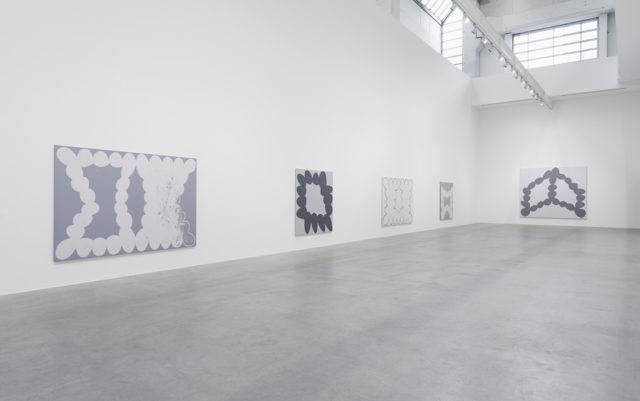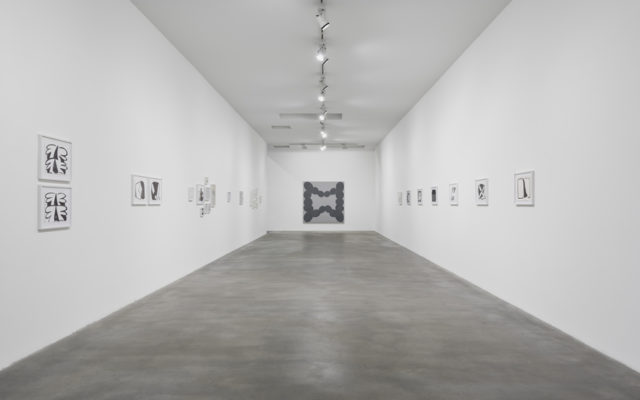
Amy Feldman at Blain|Southern, Installation view
Amy Feldman
Breath Myth
11 February — 8 April 2017
Blain|Southern, Berlin
I have to hand it to NYC-based painter Amy Feldman: not every artist can cause me to temporarily lose the will to carry on writing and the energy to carry on chronicling our bankrupt, post-meaning culture. What, I wondered as I walked around the palatial Blain/Southern Gallery, is the damned point anymore? Confronted on all sides by Feldman’s aggressively vacuous, massive canvasses, I can’t even argue conclusively that Feldman’s work is good or bad. It operates so outside of any qualitative value scale that I understand—as if attacking the very idea of value—that it defeats all rational readings of art or art making. All I can do is respond. And respond I must.
To wit, here is what you can see when you enter the gallery: large canvases on all sides, large enough to be read as “statement works” (granted, I found the notebook-sized paper works on offer in the gallery’s upstairs space, works that appear to be simple studies for her canvasses, charmingly silly and aware of their ephemeral status). Each of these large canvasses is covered in a dull gray base, a flat undercoat. On top of these surfaces Feldman doodles a few uncomplicated, abstract shapes, mostly with single brush strokes. And that’s it, folks.
Of course, I acknowledge that a) Feldman has plenty of supporters and b) her works, near-figurative abstracts mostly in various hues of gray, are not without precedent. I am always willing to work with what’s in front of me, and also acknowledge that some of my distaste for these works could (emphasis could) be because I am older than the artist and have seen and written about a lot of art over the years. Maybe I am just out of the proverbial loop on this one.
I see Keith Haring’s jumpy, child like lines in these works, and of course Louise Nevelson’s favoured charcoal palette is referenced, as well as Louise Bourgeois’s body and internal organ sourced shapes. But setting Feldman’s cues aside, I find the work uninspiring, as it seems to have no goals. In interviews, Feldman has repeated that she paints first and foremost from a kind of casual assembling of feelings and associations. And that is of course fine, make art however you like, but when the end product is a few not well brushed lines on a flat background, you are asking the viewer to fill in the proverbial blanks. I tried, and I found there was not enough to respond to, that I could not fill in the blanks because the work leads me only to a dead stop.
After trying so hard to find something beyond the clumsy surface of these paintings, I began to wonder if I was an unwilling participant in a vast art-world hoax, a ruse predicated on the sucker-born-every-minute understanding that in contemporary culture all you have to do to turn something into a praise-worthy object is simply position it as a praise-worthy object. The art world will then haplessly fill in the blanks itself, as the art world cannot stand a vacuum any more than the world of, say, political information peddling, which is also now post-everything.
Thinking I was way off base, I read some other critics’ takes on Feldman’s massive abstract paintings (an approach I rarely take, liking my own mind).

Amy Feldman at Blain|Southern, Installation view
In Art in America, one adventurous sort declared that after viewing Feldman’s works “One suspects a critique of consumerist Western culture, of the growing abyss between dearth and excess”. The revealing word in the sentence above is “suspects”. Because, of course, all you can do with paintings that appear to have been made by a ward of distracted Thorazine swallowers who ran out of brushes and paint is “suspect” that there must be something, anything, going on – otherwise, you would have to admit that the art was as devotedly inconsequential as it appears. And we can’t have people walking around thinking what is in front of them is reality. That would truly tip over the miserable dung cart of fakery, cynicism and shrugging resignation that feeds and sustains such dead-inside art.
Again, I asked myself—I have to live through another nihilistic, gamed cultural moment? (See discussion of my age and possibly too long career above). As if the careerist chicaneries of the 80s were not enough. And why, sidebar question, are the people with the most in this world (such as Feldman, who has multiple degrees, dealers all over the place, and lives in Brooklyn) the first people to show us how much they don’t care about the world, by making art that dares you to find any content? Are we entertained, to quote a movie about cold-blooded spectacles?
On the other hand, when you can make an international and profitable career out of painting like you’ve never seen a painting before, why wouldn’t you? Maybe artists like Feldman, artists who play the “I dare you to find anything here” game (a high stakes but also high payout game) are truly onto something, onto a whole reading of the art world that is too heartbreaking for most of us to say out loud: nobody cares anymore. Except the buyers.
I showed a friend a selection of Feldman’s works, a friend who happens to be an accomplished novelist who grew up in poverty in the UK. His response was that all I was doing by showing him these lazy paintings was affirming his long-held suspicion that the art market really existed to give frivolous rich people a way to show off how much play money they have. Feldman’s paintings are that and that only – light amusement for jaded buyers.
The works have no redeeming qualities other than as oversized examples of how shitty and decadent times have become. Feldman’s paintings are the wall-based equivalent of hiring peasants to play at being peasants in your estate gardens, the extra chandeliers in the posh hotel lobby, the last dollops of gold and poured blue glass on King Tut’s 25 pound funeral mask, the extra season of Girls; flitting, careless excess and high-brow gluttony rendered into being with a gutting, lurid insincerity.
If the above sounds like the ravings of an anti-art reactionary, well, you are half right. I am reacting, angrily. Damn the torpedoes. For those of us who still believe art has a purpose in the world, a purpose higher than the creation of dead-end busy work for bored academics and their witless patrons, there’s nothing to see here.


Comments on this entry are closed.
{ 7 trackbacks }